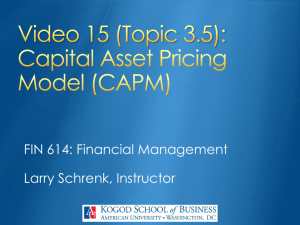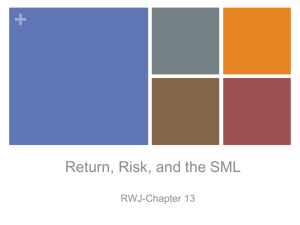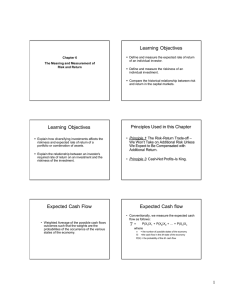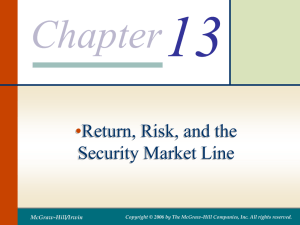The Principle of Diversification
advertisement
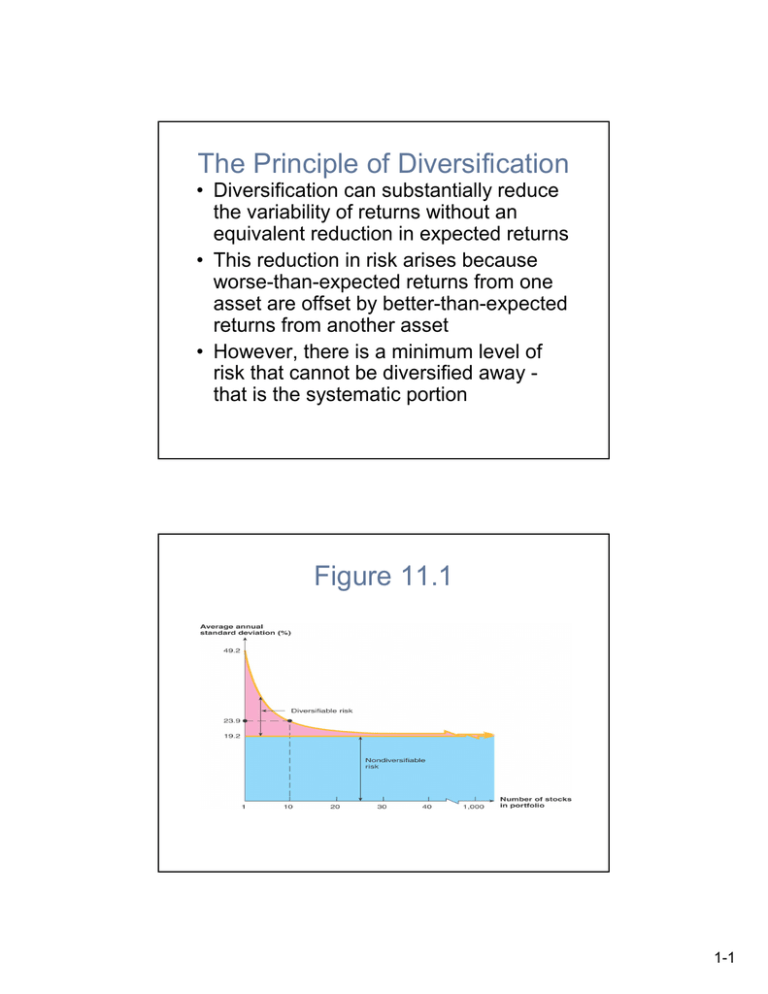
The Principle of Diversification • Diversification can substantially reduce the variability of returns without an equivalent reduction in expected returns • This reduction in risk arises because worse-than-expected returns from one asset are offset by better-than-expected returns from another asset • However, there is a minimum level of risk that cannot be diversified away that is the systematic portion Figure 11.1 1-1 Diversifiable Risk • The risk that can be eliminated by combining assets into a portfolio • Often considered the same as unsystematic, unique, or asset-specific risk • If we hold only one asset, or assets in the same industry, then we are exposing ourselves to risk that we could diversify away Total Risk • Total risk = systematic risk + unsystematic risk • The standard deviation of returns is a measure of total risk • For well-diversified portfolios, unsystematic risk is very small • Consequently, the total risk for a diversified portfolio is essentially equivalent to the systematic risk 1-2 Systematic Risk Principle • There is a reward for bearing risk • There is not a reward for bearing risk unnecessarily • The expected return on a risky asset depends only on that asset’s systematic risk since unsystematic risk can be diversified away Measuring Systematic Risk • How do we measure systematic risk? • We use the beta coefficient to measure systematic risk • What does beta tell us? – A beta of 1 implies the asset has the same systematic risk as the overall market – A beta < 1 implies the asset has less systematic risk than the overall market – A beta > 1 implies the asset has more systematic risk than the overall market 1-3 Table 11.8 Total versus Systematic Risk • Consider the following information: – Security C – Security K Standard Deviation 20% 30% Beta 1.25 0.95 • Which security has more total risk? • Which security has more systematic risk? • Which security should have the higher expected return? 1-4 Example: Portfolio Betas • Consider the previous example with the following four securities – – – – – Security DCLK KO INTC KEI Weight .133 .2 .267 .4 Beta 4.03 0.84 1.05 0.59 • What is the portfolio beta? • .133(4.03) + .2(.84) + .267(1.05) + .4(.59) = 1.22 Beta and the Risk Premium • Remember that the risk premium = expected return – risk-free rate • The higher the beta, the greater the risk premium should be • Can we define the relationship between the risk premium and beta so that we can estimate the expected return? – YES! 1-5 Example: Portfolio Expected Returns and Betas 30% Expected Return 25% E(RA) 20% 15% 10% Rf 5% 0% 0 0.5 1.5 bA 1 2 2.5 3 Beta Market Equilibrium • In equilibrium, all assets and portfolios must have the same reward-to-risk ratio, and each must equal the reward-to-risk ratio for the market E(RA ) - Rf bA = E(RM - Rf ) bM 1-6 Security Market Line • The security market line (SML) is the representation of market equilibrium • The slope of the SML is the reward-torisk ratio: (E(RM) – Rf) / bM • But since the beta for the market is ALWAYS equal to one, the slope can be rewritten • Slope = E(RM) – Rf = market risk premium Capital Asset Pricing Model • The capital asset pricing model (CAPM) defines the relationship between risk and return • E(RA) = Rf + bA(E(RM) – Rf) • If we know an asset’s systematic risk, we can use the CAPM to determine its expected return • This is true whether we are talking about financial assets or physical assets 1-7 Factors Affecting Expected Return • Pure time value of money – measured by the risk-free rate • Reward for bearing systematic risk – measured by the market risk premium • Amount of systematic risk – measured by beta Example: CAPM • Consider the betas for each of the assets given earlier. If the risk-free rate is 3.15% and the market risk premium is 9.5%, what is the expected return for each? – – – – – Security DCLK KO INTC KEI Beta 4.03 0.84 1.05 0.59 Expected Return 3.15 + 4.03(9.5) = 41.435% 3.15 + .84(9.5) = 11.13% 3.15 + 1.05(9.5) = 13.125% 3.15 + .59(9.5) = 8.755% 1-8 SML and Equilibrium 1-9
